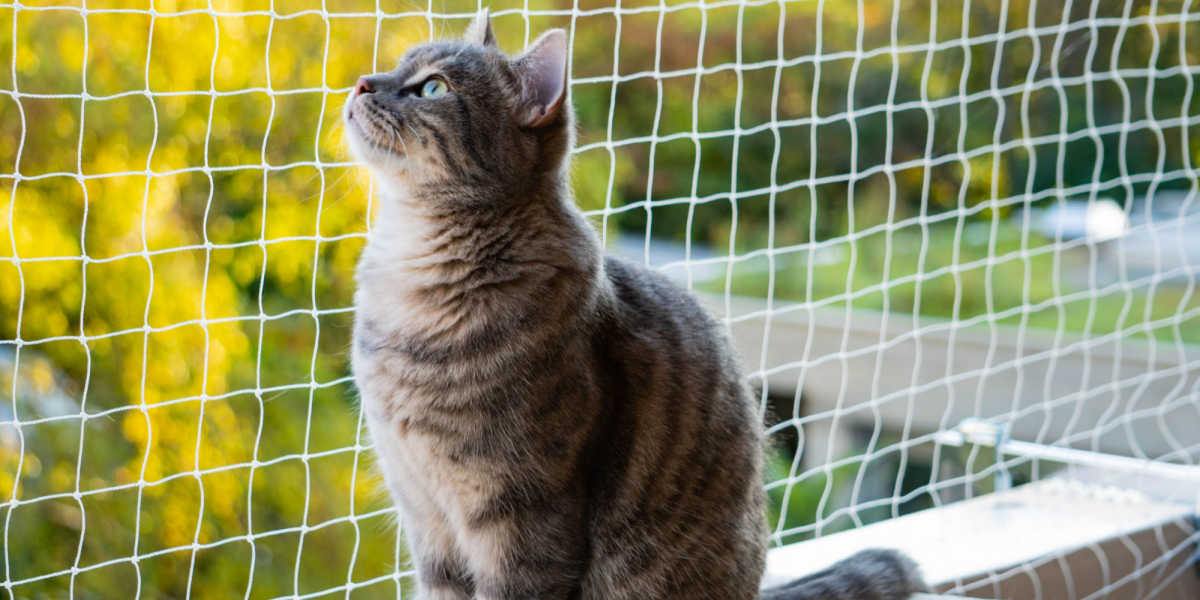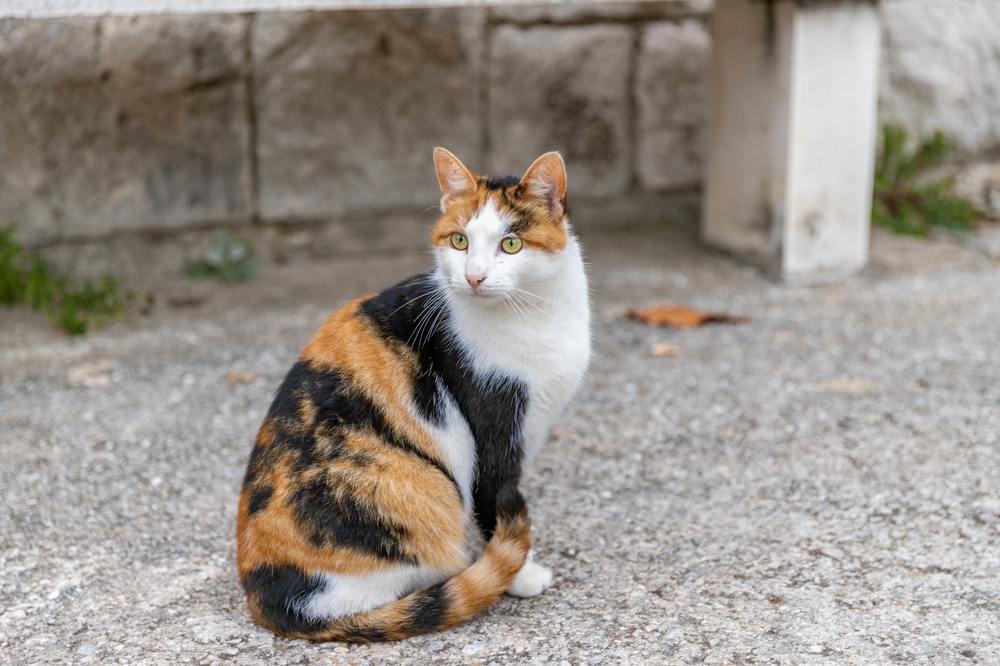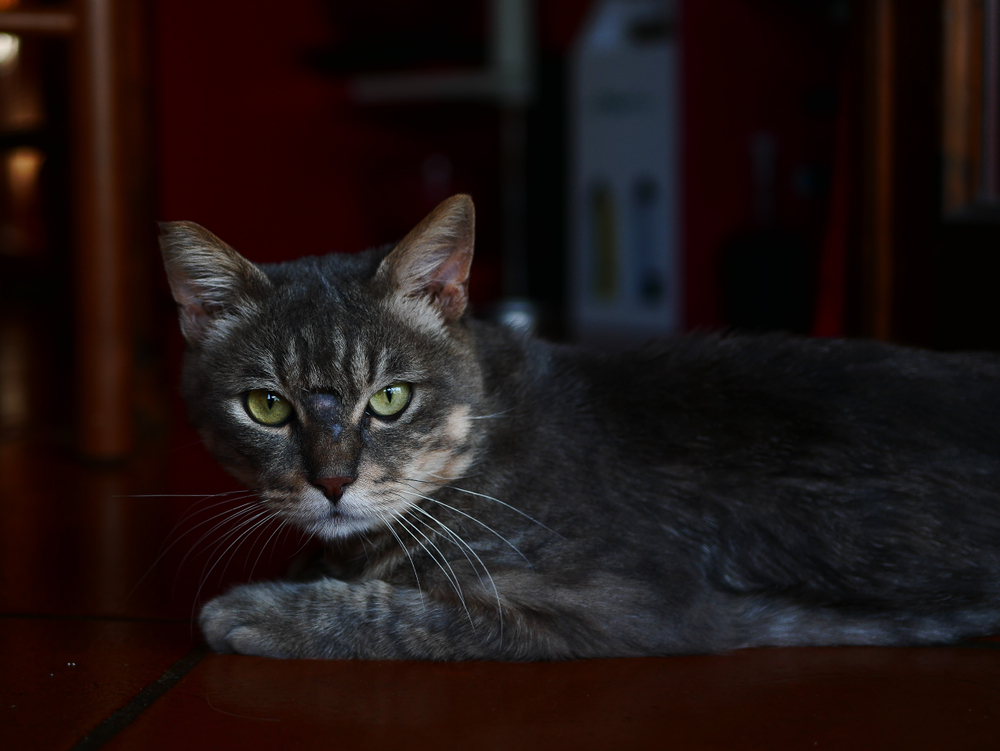
Feline vision is quite different from human vision, and what pet parents might consider to be color blindness might in fact be perfectly normal for cats. But there are different kinds of color blindness, even between people, dogs, and cats.
Feline vision is very different from human vision, including variation in how they perceive colors. Cats have different proportions of the photoreceptors rod and cone cells compared to humans, leading to better night vision and peripheral vision but poorer visual acuity and color perception. It is uncertain exactly what colors cats can see, or whether they see all the colors that we do, but just at less intensity.Key Takeaways
In this article, you’ll learn what’s unique about cats that make them see color differently than we do, any considerations you should take at home, and some frequently asked questions.
Also Read: Cat Vision Vs. Human Vision: Who Has Better Vision?
How the Eye Works
To understand cat color blindness, it’s first necessary to know the different parts of the feline eye and what they do.
Images are processed by the eye by first allowing light to enter, which then gets translated into an image. Light first enters through the outer protective layer of the cornea. The iris, the colored part of the eye, is a muscle that can change the pupil size to filter how much light passes through.
Light then passes through the lens which helps to focus the image, and continues on to the back of the eye to the retina. Situated at the very back of the eye, the retina has vision receptors, and is what is responsible for processing light into a visible image.
The retina contains structures called photoreceptors. There are two types called rods and cones. Rods are used mostly for vision in the dark and at night as they are activated by a minimal amount of light.
Cone cells require much more light to be activated and are involved with how much color we see. Humans have three types of cones, allowing us to see blue, green, and red. Differences in the types of cones an animal has as well as the proportion of rods versus cones, both play into how well color is perceived.
Also Read: Why Do Cat Eyes Dilate?
What Colors Can Cats See?

Feline vision differs from ours, but they still likely see a range of colors.
Contrary to some belief, cats can certainly see color. In fact, most animals see some different colors as a general rule, instead of only seeing in black and white. But there are big differences in how much color different animals see.
Let’s look at humans first as a place to start. Humans have three types of cones, allowing us to see blue, green, and red. While it may seem that we probably see the best of any animal though, we actually don’t. Fish and some birds have a fourth photopigment that allows them to see light in the ultraviolet spectrum too. So if you have a bird or fish at home, they can see a far richer color spectrum than you can!
On the opposite end of the spectrum, strictly nocturnal animals, like racoons, only have one photopigment. This means they can really just see variations of one color, usually red or green.
Dogs, horses, and cattle have two photopigment populations. These animals can see blue-violet but have trouble distinguishing between red, green, and yellow. In this way, the vision of dogs may be the closest to people who are described as red-green color blind.
Cats are actually the closest to people, with three populations of cone photopigments, just like we have. The main difference in color perception between people and cats is in the number of cones they have compared to us.
Humans reportedly have 10 times as many cones as cats do, and we have a far greater concentration of them. But on the flip side, cats have about 6 to 8 times more rod cells than we have, which allows them to see much better in the dark and increases peripheral vision.
Although cats have three populations of cones, the far reduced number of them compared to humans has led to debate over how rich a spectrum of colors cats can actually see. Some scientists believe cats see more in shades of blue or grey, while others believe cats may have more of a red-green color blindness, similar to dogs.
While the debate over specifics may continue, you can at least know that your cat does see a range of colors–just not as rich a spectrum of colors as we see. But the trade-off? Our feline friends can sneak around at night with precision instead of stumbling and bumbling like we humans.
Also Read: When Do Kittens Open Their Eyes?
Causes of Cat Color Blindness
As you’ve learned, cats have a degree of color-blindness as a rule, at least as compared to humans, fish, and some birds. But why the differences?
It’s thought that over a very long time, cats evolved to have better vision at night, as this can be advantageous for hunting and scavenging. In order for this to happen, the number and concentration or rods had to increase, but at the cost of fewer and less concentrated cones.
On the flip side, there’s far more advantage for us being able to see in well-lit conditions and be able to process complex color combinations and detail.
Also Read: Heterochromia In Cats: Cats With Different Colored Eyes
Can I Tell That My Cat Is Color Blind?

It can be very difficult to tell if your cat is color blind, as long as their vision does not impair their everyday life.
Although cats see the world of color a little differently than we do, this shouldn’t be considered an impairment and there isn’t anything during the regular day to day that you need to keep an eye out for.
Although some colors we see may be indistinguishable for a cat, they can still see objects and obstacles and their color perception doesn’t change how they interact with their environment, at least for the necessities.
If you just got your kitty a bright red and green mouse toy, it may not look as vibrant and interesting to your cat, but a mouse toy is a mouse toy and it’s still a very exciting thing to play with.
Are There Other Ways My Cat’s Vision Is Different From Mine?

Cats have evolved to see well in dim light, perfect for hunting at their most active times of dawn and dusk.
Color isn’t the only difference between how cats perceive their world compared to us. There are a couple of other differences to be aware of too.
1. Night Vision
There are other reasons cats can see so well at night besides just the high number and concentration of rods that they have. Cats, like many carnivores, including dogs, have a reflective layer at the back of their eyes called the tapetum lucidum.
If you’ve ever caught a cat’s or dog’s eyes in the dark with a flashlight, the appearance of their “glowing” eyes is what you’re seeing. The tapetum reflects further light towards the retina, allowing for better vision in low light conditions.
Cats have corneas and pupils 50% larger than those of humans, allowing more light to enter the eye. The combination of these great adaptations is the reason cats can reportedly see in light that is 6 times dimmer than the lowest level of light that we humans can detect.
Also Read: Why Do Cats’ Eyes Glow In The Dark? The Answer Might Surprise You…
2. Visual Acuity
Cats’ excellent night vision does have other trade-offs though. The tapetum lucidum and concentration of rods allow for great detection of quick movements in dim light–great for hunting.
But in the daytime, cats have some disadvantages. In addition to not having as rich a color spectrum to see, cats are also a bit nearsighted. If a human can see an object about 100-150 feet away, a cat trying to see the same object wouldn’t be able to see it until about 20 feet away.
Cats also have some trouble focusing on objects compared to humans. To focus on objects, a process called accommodation, the lens within the human eye can actually narrow and widen with the help of tiny muscles. Cats lack this ability. In order to focus, the lens actually shifts forward and backward within the eye, which is not quite as successful at fine-tuning focus.
3. TV
Ever wonder why your cat has little interest in watching television with you? It could certainly be the show you’re watching, but it can also be related to how they perceive the image. The photoreceptors in the retina require a certain amount of time to “recharge” before they can receive a new signal.
A flickering image, when flickering quickly enough, will blend into a continuous image to the eye of the viewer. Think of a flip book, which has an image on each page that you can flip through. When you flip through them slowly, each page looks like a single picture. But flip through it fast enough, and now the images run together and appear to be in continuous motion.
In humans, the recharge rate of cones in the eye, allowing images to “fuse” together is 40 Hz. TV screens flicker at around 60 Hz, making what you see appear to be in continuous motion. But in many other animal species including cats, the cones of the eye recharge at a much higher frequency, around 70-80 Hz.
This means that when your cat watches TV, they don’t see a continuously moving image but flickering, interrupted images instead.
Also Read: Is Cat TV Really Good For Cats?
Cat Vision Care Tips

If your cat’s behavior changes, or their eyes look different to usual, seek advice from a DVM.
Even if your cat’s eyes are different from yours, there isn’t anything you need to do normally to help accommodate them. They may not see in the same color scheme, be able to see a toy you dangle at them from 200 feet away, or have interest in watching TV, but they are well adapted to their needs.
It is important, especially as your cat gets older, to be on the lookout for real signs of vision problems. Here are a couple points of monitoring to look for that your cat may have a medical issue with vision:
- Your cat bumps into things in the home, especially if the “normal” layout has recently changed.
- Your cat wanders the home, appearing to be “lost”.
- Your cat appears hesitant to jump up to previously familiar areas.
If you’re concerned about your cat’s eyes, or their vision, then contact your veterinarian.
Also Read: Why Do Cats Blink?
Frequently Asked Questions
What Colors Can Cats See?
There is some debate in terms of what colors cats can actually see. Cats have the same three cone photopigments that people do to perceive color: red, blue, and green. However, they have far fewer of them. Some scientists believe they see more shades of blue and grey, while others think cats have trouble seeing shades of red and green, blending more into yellow.
Why Do Cats Have Poor Color Vision?
Cats have poor color vision compared to people because they have far fewer cone photoreceptors compared to rods. Cones are responsible for seeing combinations of colors in brighter light conditions while rods help perceive shades of grey in dim light conditions.
What Does Cat Color Vision Look Like?
There is some debate over what types of colors cats can actually see. Since they have all three red, blue, and green populations of cone photopigments but not as many as we do, some feel that cats may just see a less robust intensity of some colors. Others feel cats may have altered ability to see the colors that we do.
Do Colorblind Glasses Work on Cats?
There is still debate over what arrays and intensity of colors cats can see. Color blindness glasses work by using minerals to filter out certain wavelengths of green and red, helping those colors to be more distinct. As we don't yet fully understand feline color vision, it is difficult to say what affect these glasses would have.
-
Ofri, R. Vision in the Animal Kingdom. World Small Animal Veterinary Congress Proceedings. 2008. Accessed through the Veterinary Information Network May 4, 2023. https://www.vin.com/apputil/content/defaultadv1.aspx?id=3866640&pid=11268
-
Ofri, R. Vision in Dogs and Cats. American Veterinarian. 2018; 3 (6). Accessed through DVM360 May 4, 2023. https://www.dvm360.com/view/vision-in-dogs-and-cats
-
Ghose, T. Feline Vision: How Cats See the World. Live Science. Published October 16, 2013. Accessed May 4, 2023. https://www.livescience.com/40459-what-do-cats-see.html
-
Trupanion. Are Cats Color Blind? Accessed May 4, 2023. https://trupanion.com/pet-care/are-cats-color-blind







